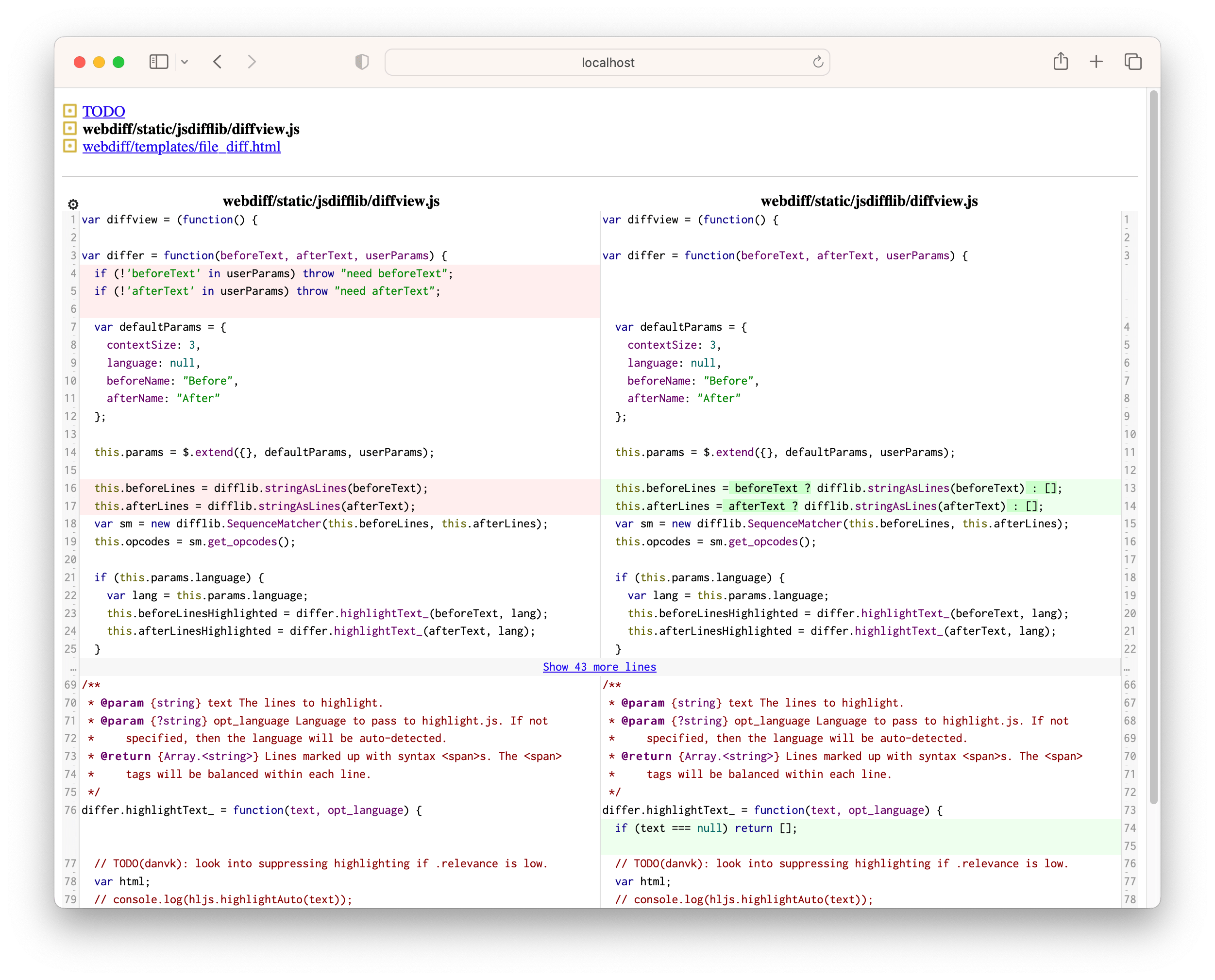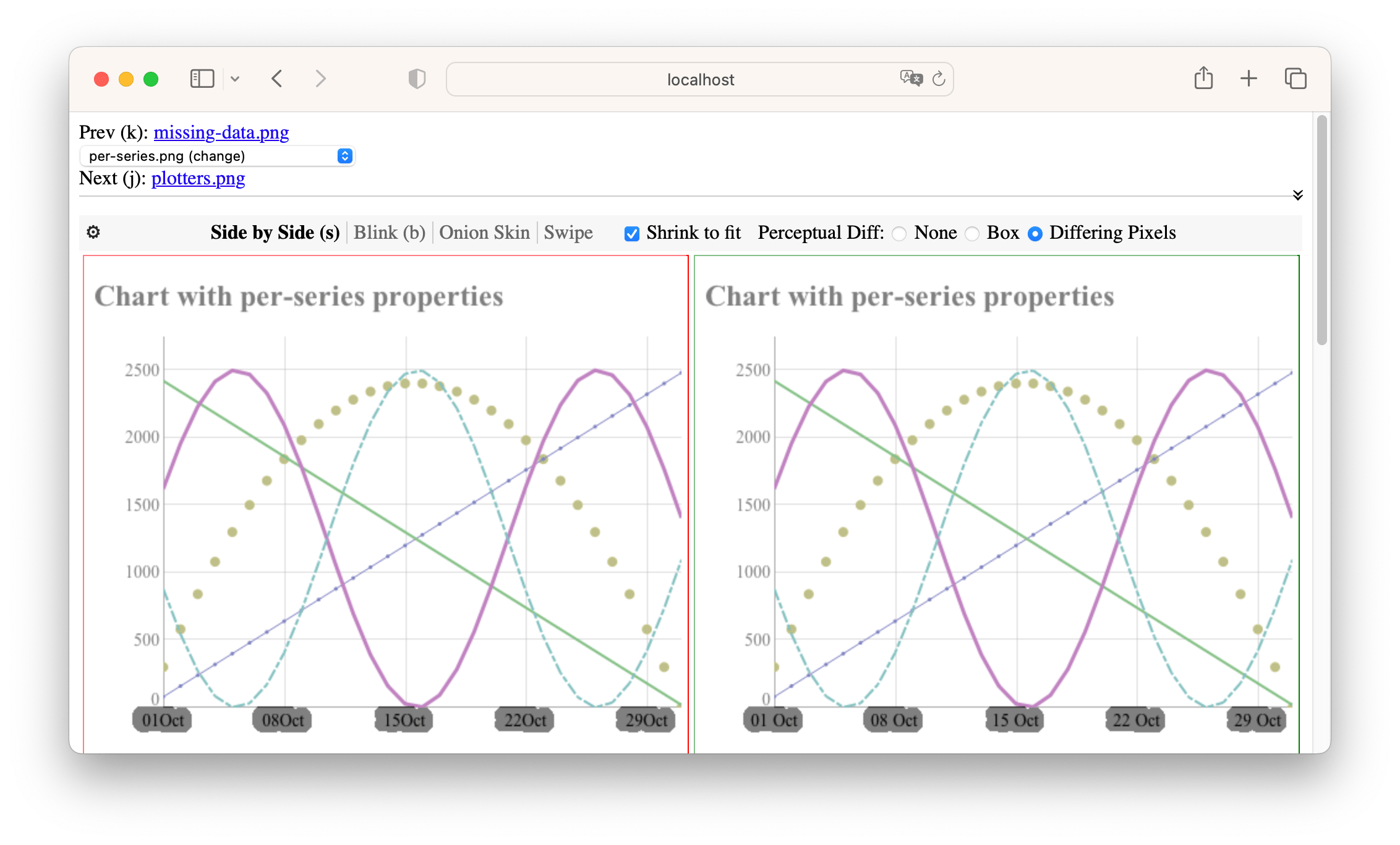Two-column web-based git difftool.
Features include:
- Side-by-side (two column) diff view
- Runs in the browser of your choice on any platform.
- Syntax highlighting via highlight.js
- Step back and forth through multiple files in a single diff
- Rich support for image diffs
pip install webdiff
or, if you prefer Homebrew:
brew install danvk/webdiff/webdiff
(the latter will also install ImageMagick as a recommended dependency.)
Instead of running "git diff", run:
git webdiff
You can also start webdiff via:
git webdiff [args]
You can pass all the same arguments that you would to git diff, e.g.
1234..5678 or HEAD.
webdiff can also be invoked directly to diff two directories or files:
webdiff <left_dir> <right_dir>
webdiff <left_file> <right_file>
You can also use webdiff to view GitHub pull requests:
webdiff https://github.com/owner/repo/pull/123
webdiff '#150' # if you're in a git repo with a github remote
This will download the files relevant to the Pull Request and run webdiff.
If you run into GitHub API quota limits or you'd like to use webdiff with
private repos, you can set your credentials in a .githubrc file:
user.login: yourusername
user.token: your-personal-access-tokens
Make sure you chmod this file to only be readable by yourself. You can generate a personal access token for webdiff via github.com → profile → Settings → Personal access tokens. Make sure to grant all the "repo" privileges.
You can also use git webshow in place of git show to show a single commit:
git webshow HEAD
git webshow REF is shorthand for git webdiff REF^..REF.
webdiff can be configured via git config. To change the syntax highlighting theme, for example:
git config webdiff.theme rainbow
(You can find a list of supported themes in the themes directory.)
As with any git configuration setting, these can be set globally or per-repo.
Options are:
| Setting | Default | Notes |
|---|---|---|
| webdiff.theme | googlecode | Syntax highlighting theme (see themes directory). |
| webdiff.port | -1 | Port on which to serve webdiff. Default is random open port. This can be overridden with the --port command line flag or the WEBDIFF_PORT environment variable. |
| webdiff.host | localhost | Host name on which to serve the webdiff UI. Use 0.0.0.0 to serve publicly. The special value <hostname> uses your computer's network name. This can be overridden with the --host command line flag or the WEBDIFF_HOST environment variable. |
| webdiff.maxDiffWidth | 100 | Maximum length of lines in the diff display. After this width, lines will wrap. |
| webdiff.unified | 8 | Lines of context to display by default (git diff -U) |
| webdiff.extraDirDiffArgs | "" | Any extra arguments to pass to git diff when diffing directories. |
| webdiff.extraFileDiffArgs | "" | Any extra arguments to pass to git diff when diffing files. |
| webdiff.openBrowser | true | Whether to automatically open the browser UI when you run webdiff. |
| webdiff.maxLinesForSyntax | 10000 | Maximum lines in file to do syntax highlighting. |
| webdiff.colors.delete | #fee | CSS background color for delete (left) lines |
| webdiff.colors.insert | #efe | CSS background color for insert (right) lines |
| webdiff.colors.charDelete | #fcc | CSS background color for deleted characters in a delete (left) line |
| webdiff.colors.charInsert | #cfc | CSS background color for inserted characters in an insert (right) line |
poetry install
cd ts
yarn
# see https://github.com/webpack/webpack/issues/14532
NODE_OPTIONS=--openssl-legacy-provider webpack
Then from the root directory:
poetry run webdiff/app.py testdata/dygraphsjs/{left,right}
or to launch in debug mode:
./test.sh $(pwd)/testdata/manyfiles/{left,right}
(or any other directory in testdata)
To run the Python tests:
poetry run pytest
To format the code, run:
poetry run ruff format
cd ts
yarn prettier
To debug git webdiff, run:
./test-gitwebdiff.sh
To iterate on the PyPI package, run:
pip3 uninstall webdiff
poetry build
pip3 install dist/webdiff-?.?.?.tar.gz
To publish to pypitest:
poetry build
poetry publish -r testpypi
And to the real pypi:
poetry publish
See pypirc and poetry docs for details on setting up tokens for pypi.
Publication checklist. Do these from outside the webdiff directory:
- Run
webdiff webdiff/testdata/.../{left,right} - Run
git webdiff 52aa15f^..52aa15fin the codediff.js repo - Run
git webshow 52aa15ffrom the codediff.js repo (should be same as previous command) - Run
webdiff https://github.com/danvk/webdiff/pull/160
webdiff doesn't calculate any diffs itself. Instead, it relies on git diff. This is possible because git diff has a --no-index mode that allows it to operate outside of a git repository. Of course, this means that you need to have git installed to use webdiff!
When you run webdiff dir1 dir2, webdiff runs:
git diff --raw --no-index dir1 dir2
To ask git which files are adds, removes, renames and changes. Then, when it's serving the web UI for a particular diff, it runs:
git diff --no-index (diff args) file1 file2
This produces a patch, which is what the web UI renders. (It also needs both full files for syntax highlighting.)
When you run git webdiff (args), it runs:
git difftool -d -x webdiff (args)
This tells git to set up two directories and invoke webdiff leftdir rightdir.
There's one complication involving symlinks. git difftool -d may fill one of the sides (typically the right) with symlinks. This is faster than copying files, but unfortunately git diff --no-index does not resolve these symlinks. To make this work, if a directory contains symlinks, webdiff makes a copy of it before diffing. For file diffs, it resolves the symlink before passing it to git diff --no-index. The upshot is that you can run git webdiff, edit a file, reload the browser window and see the changes.





